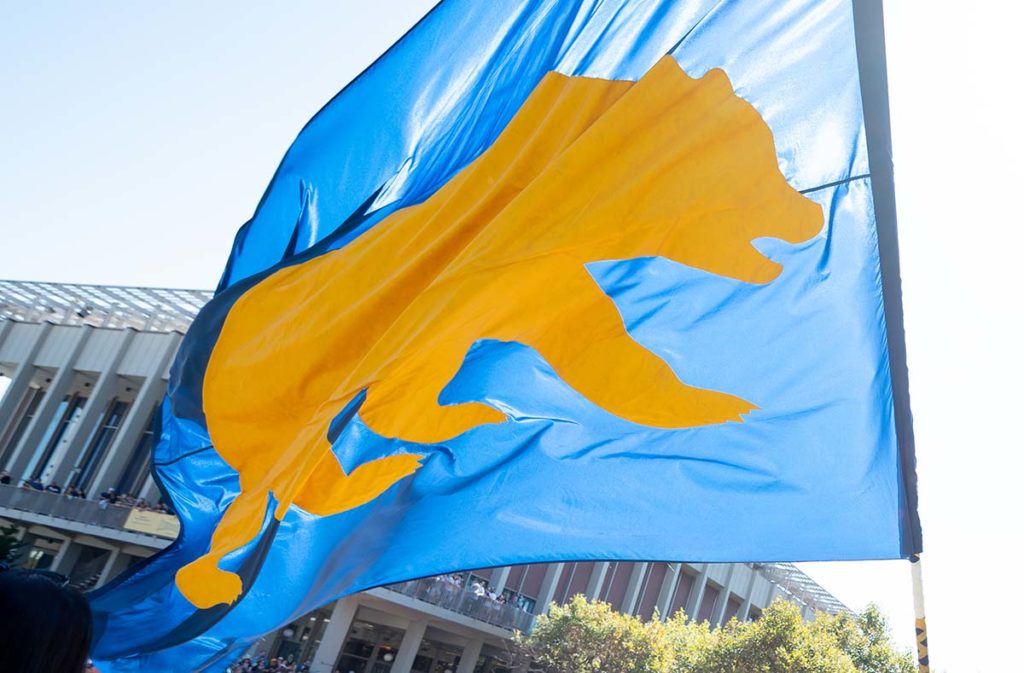The first time Larry Zhou traveled outside of China, it was to start his freshman year at Berkeley in 2010. The University’s bid to admit more international students—they would enhance campus diversity and pay sticker-price tuition—brought a surge of foreign arrivals with Zhou. More than a third came from Chinese territories.
Zhou, now a senior, had studied British English in high school in Suzhou, about 65 miles west of Shanghai. He did so well on a language test that his school encouraged him to study abroad, and he garnered a high verbal SAT score as well.
But when he arrived on campus, Zhou quickly realized that his test scores might have overstated his English language skills. He had trouble making himself understood to his roommates. And he struggled with writing. (Among other things, he had no idea what “double space” meant.) In his second semester, he asked for an exception and took Writing R1A, a course normally reserved for those with relatively low verbal SAT scores. “That class was way over-demanded. Of the international students, I don’t think many of them were able to get in,” Zhou recalls. “The University was not prepared.”
If both the University and international students themselves initially underestimated what this influx of newcomers would require to succeed, the new reality soon became crystal clear. In the past, Cal’s prime assistance to foreign students had been steering older graduate students through the bureaucracy to extend their visas. Today’s international students are younger, and their needs more profound. They are teenagers, arriving from overseas and immediately plunged into a culture that feels strange, baffling and sometimes indecipherable. Many struggle not just with English and unfamiliar social norms but with isolation— a homesickness even more acute than the traditional freshmen flu because home is thousands of miles away. Many feel intense pressure from their families who expect them to excel academically and, preferably, to save money by earning a degree in record time.
“They’re dealing with learning all this academic stuff in a language that they’re not necessarily proficient in. They’re under a lot of stress financially and economically to succeed; their families have invested a lot in them,” says Jeff Prince, the head of Counseling and Psychological Services.
And amid all these stressors, many have from childhood absorbed a taboo against asking for help.
The University, which has been scrambling to figure out how best to welcome its international contingent of undergraduates, has had to respond quickly to fill in the gaps—and to pull that off with scarce funding. The advising office took to Skype and YouTube to guide students through the somewhat Byzantine system of choosing and registering for classes. Prince and other counselors traveled to China this past summer for a novel exchange program with universities in Shanghai in which they learned more culturally effective ways to provide therapy to Chinese students. And Cal has added special sections of its entry-level course reserved for so-called multi-language writers.
Such extra support can make a big difference. In Zhou’s case, the ability to take English R1A provided the extra language boost he needed. Today he is writing an honors thesis in sociology as one of a small minority of Asian nationals to major in something other than hard sciences, math or business.
“The learning is endless. We always have more to learn about culture and about student success and the factors that make a difference,” says Prince. But he also describes meeting the challenge as quintessentially Berkeley. “We’ve always been on the forefront nationally for using best practices and having a multi-cultural staff. It’s just part of our values.”
How did the University get to this point? The answer can be traced to the brutal state budget cuts of recent years, followed by the UC system’s decision to award more coveted admissions slots to foreign and out-of-state students who pay full-fare. While Berkeley was following a national trend of prestigious public and private U.S. universities that had done just that, its international undergraduate population has since leap-frogged those of many other universities.
Between 2010 and 2012, the number of foreign undergraduates studying in the United States increased by 6 percent. At Berkeley, it rose by a third to nearly 2,700 students. Five years ago, less than 1 percent of the incoming freshman class of 2008 came from abroad; now 6 percent do.
International students come to do just as well on average, academically, as U.S. students. (The exception is international students who transfer from elsewhere into Berkeley, and experience higher rates of academic probation.) But counselors here say foreign students overall do suffer from greater social and academic stress.
And consider the experience of the Berkeley International Office, which handles visa issues for the University’s international students and scholars. By 2010, the office suddenly found itself facing lines of 18 year-olds with myriad questions. “We went from having advising conversations that were very much focused on students’ dissertations and the academic job market, to having conversations about finding on-campus jobs to support the next three years of their undergraduate educations, trying to find housing, trying to understand what a housing contract is and how to work with it,” says Rebecca Sablo, assistant director for student services at the international office.
The office has expanded its role to include translating the University bureaucracy for international students.
It’s one thing to leave it to a tiny smattering of international students who come from elite backgrounds to bridge the gap of cultural difference on their own. But with the University’s business model increasingly reliant on recruiting students from China, Korea and other Asian countries, the burden is on the University to help them bridge the cultural gap — if only because failure to do so will sabotage recruiting efforts.
“International students can report very easily, ‘Berkeley is not the place to go. They only see international students as cash cows; they don’t care how you do.’ We can’t afford to get it wrong,” says Cara Stanley, the director of the Student Learning Center and a lecturer in African American Studies.
For their part, Chinese students come to Berkeley because China doesn’t yet have enough high-caliber universities to handle the many rising middle-class students who want a college education. The students are keener on Berkeley than, for example, their Indian counterparts—who account for less than 5 percent of incoming international students—because the People’s Republic of China prizes public institutions.
The tuition these middle-class students pay is a significant sacrifice for their families, according to Amy Jarich, the director of undergraduate admissions. Financial concerns are the single greatest pressure that international students report. Many take additional units each semester hoping to save money by finishing faster.
And missteps can be costly, if not irreversible. Kevin Wang, a senior from Shanghai who attended boarding school in Germany, arrived, like Zhou, just in time to begin the fall semester in 2010. Few international students are able to visit Berkeley over the summer to attend one of the CalSO orientation sessions, which also offer academic advising. Wang didn’t see an advisor until his sophomore year, as he tried to decide on a major.
“I took the wrong classes in the first semester because no one could give me any advice,” he says.
Initially planning to major in physics, he took a challenging physics class his first semester, and eventually opted to change his grading option to pass/no pass rather than accept a B. The decision, he later learned, blocked him not just from majoring in physics but also several other science and engineering majors. He eventually settled on a double major in business administration and creative writing.
Struggling international students repeatedly identify the University’s advising system as a fateful sticking point. This year for the first time the Letters and Sciences undergraduate advising office supplied international students with a special advising code that allowed them to register mid-way through the period. Previously, they were left, like all other students who didn’t attend CalSO, to register last.
The advising office also invited all international students to digitally submit their proposed fall schedules to get feedback—and if the feedback was substantial, advisors offered to meet with students over Skype. That required the staff to divide into early and late work shifts to accommodate the time difference.
“Out of 650 international freshmen, we received almost 430 schedules this year,” says director Roseanne Fong. “It’s a lot of work.”
In the spring, L&S advising produced more than a dozen YouTube videos to help answer some common questions about course selection. The office was able to do it with no supplemental funding thanks to the fortuitous presence of an advisor who had made videos at her previous job. The videos amassed some 10,000 total views—although not one came from mainland China, where YouTube is blocked.
Cultural issues have at times spiked the University’s ad-hoc efforts to support international students.
“The pressure on them is enormous to succeed, and they’re coming from a culture where it isn’t like in the U.S. where you seek out counseling and support; to come to counseling is like you failed and you must have a psychiatric diagnosis.”
For instance, when the international office and the Student Learning Center first tried to organize informal English conversation sessions, few came, although a significant fraction struggle with English. Organizers have since observed that events that seem to offer help for students having problems fail to draw many participants. Language exchanges with native English speakers and “coffee chats” elicit much larger turnouts. A similar tweak to the way the College Writing courses for non-native speakers were titled and described also boosted turnout.
“Many of the students coming from East Asian nations have a lot of stigmas against asking for help, or admitting that you don’t know something. In the U.S. we might say ‘the worst they can say is no,’ but that idea is totally foreign to international students,” Sablo says. She role-plays situations with some students to get them more comfortable going to their professors’ office hours and asking for academic and administrative exceptions.
For similar reasons, Asian national students are less likely to seek help from Counseling and Psychological Services despite higher levels of stress.
Prince has made what might be the boldest effort on campus to improve support, originating from his professional friendship with Vincent Yang, his counterpart at Shanghai Jiao Tong University. Yang proposed a staff exchange between Berkeley, Jiao Tong and another local university, Shanghai Ocean. The Chinese universities fully funded the exchanges: they were eager to learn from Berkeley because the very notion of therapeutic counseling is new in China.
The schools swapped staffers for a month this past summer. The Chinese therapists didn’t provide counseling because they aren’t licensed to do so in the United States; instead they shared insights about their own culture to Prince and his Berkeley team.
A key takeaway: informal gatherings that leave no record of the students’ attendance bring more participation. “The pressure on them is enormous to succeed, and they’re coming from a culture where it isn’t like in the U.S. where you seek out counseling and support; to come to counseling is like you failed and you must have a psychiatric diagnosis,” Prince says.
The cultural differences run deeper, too: Talk therapy is a Western phenomenon, dating back to Freud. One psychologist suggested strategies to overcome a Chinese cultural reluctance to share personal information with strangers, such as starting with a Tarot reading to ease students into personal conversation.
So Cal’s Counseling and Psychological Services group has started organizing events around campus billed not as mental health support but rather stress-management strategies. They don’t ask students to fill out any paperwork that would serve as evidence that they were there.
“We haven’t really had to gaze up from our own navel as Americans in the way that the rest of the world has, and international students can report back our culture to ourselves in ways that we can’t see.”
“Our staff has found it such an eye-opener,” Prince says. “The only problem I see is that from my perspective, I have to think about how do I make this program go beyond just a pilot, how do I build a sustainable exchange program where we’re not dependent on them for funding. We would need funding to give us more control over where it goes and how to develop it strategically.”
And that’s just it. Staff in most all of the offices that serve international students have done most of what they can do without any extra funding or staffing. Administrators released a trickle of funding to bolster support for international students after a 2012 task force report on the University’s efforts to become a global center of learning identified shortcomings in its services to international students.
Health services added two counselors experienced in dealing with international students, one of whom is herself a Chinese national who first came to the United States for graduate school. The Berkeley International Office has recently added one additional advisor, and the Letters and Sciences advising office is recruiting someone to assess which overseas courses should transfer for credit.
The admissions office received funding early on to bring in additional application readers who are experienced evaluating and confirming international scores and grades. (Falsifying transcripts has apparently become a cottage industry in China.)
Given that international students were once imagined to be a kind of deus ex machina for the University’s budget woes, has it worked? Or are the costs of providing more intensive services to these students undercutting the financial benefit of the surplus tuition dollars? There’s no easy answer, but two metrics provide partial clues: spending on academic support and student services. To date, tuition gains have outpaced increases in spending on academic support U.C.-wide by a factor of two, according to annual financial reports. But student services spending jumped 20 percent at Berkeley in the two years before the University stopped including them as a budget line in 2010. (The numbers are not available, officials say.) And expenses will eventually have to go up again to allow departments to catch up to student needs.
But with the students performing well and providing the diversity that administrators desire, budget calculations appear to have become a secondary consideration. Every campus staff member who spoke about the growing population of international students extolled their advantages.
“The value of having an international global population is key for the flagship university in California, given that we’re in a global economy,” says Stanley of the Student Learning Center. “We haven’t really had to gaze up from our own navel as Americans in the way that the rest of the world has, and international students can report back our culture to ourselves in ways that we can’t see.
“I’m not trying to be Pollyannaish but there’s some real magic that can take place in the classroom.”




















